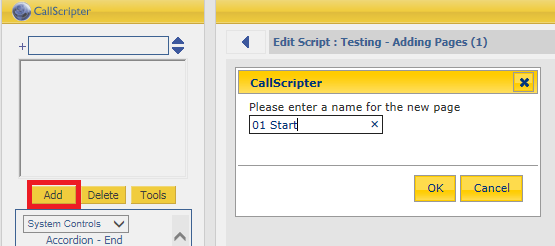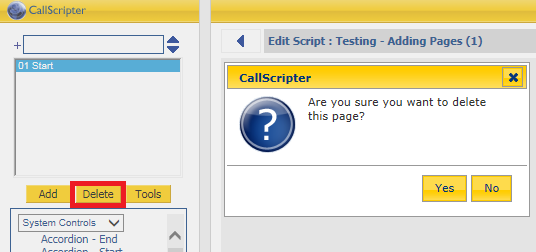Adding and Deleting Pages, Page Properties
Adding Pages
Pages can be easily added to scripts by clicking the Add button in the top left corner, and creating a new page name. Any combination of letters and numbers can be used to allow the page names to appear sequentially in the page list:

Most scripts require a minimum of three pages to allow the script to open and close correctly. Page properties are set to a page by selecting the page name, clicking on Tools - Page Properties, and selecting the appropriate property type:
|
Start Page
|
Tells CallScripter which page to launch when the script is opened
|
|
Penultimate Page
|
Allows agents to move to this page if they click on the End Call button in the Agent Toolbar. Therefore this page usually contains outcomes and notes relating to the call. Only one page can be set as the Penultimate page, so if the script does contain other pages which may be considered Wrap pages, ensure the Penultimate page is the one you wish agents to see when they click the End Call button.
|
|
Last Page
|
Closes the script. This page is commonly left blank and is not seen by the agent. This page can be used to carry out post-script actions (for example, populating the DNC (Do Not Contact) table. See notes below for further information.
|
Deleting Pages
Pages are deleted by selecting the page name and clicking on the Delete button:

Page Properties
This section provides more detailed information regarding page properties, their behaviour and limitations:
Last Page
The Last page is not seen by the agent, so usually will not contain any controls. Some customers use this page to run post-script action, including database controls. If this is the case the following should be considered:
-
Ideally no controls should be added to the Last Page.
-
Any data controls placed on the Last Page will load in the order in which they are placed.
-
Certain controls (for example, database controls that contain a lot of code, or the server is under load) do not run quick enough to return the data to the page before the page is closed in IIS. Even if the script has been tested it is importantto bear in mind that in the real environment results can vary depending on the number of users, reports being generated, etc.
-
As the Last Page is never rendered any client side code will not fire. This is due to the server side code firing on page request before CallScripter recognises that the Last Page has been launched.
-
Any controls that load before JavaScript can be added on this page, but once JavaScript starts to run the first thing it will do is close the page. Therefore it is advised that no custom JavaScript items are placed on this page if other controls are used (for example, any database controls).
-
CallScripter recommend any data controls are placed on a separate page, with a button set to autoclick and move to the End call page.
Start Page
Each time a script is opened a new Session ID is created. For Versions pre-4.5.33 if an agent refreshes (using F5) the Start page (before they have navigated to another page) it will create a new SessionID. This number can be used for many purposes, including reporting on script data collected, or managing tasks, so the creation of multiple session IDs can cause issues. If the agent has already moved to another script page, then goes back to the Start page, and then refreshes CallScripter will not create a new Session ID. The problem only arises if they haven't navigated elsewhere before hitting F5, and only in versions pre-4.5.33.